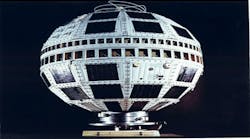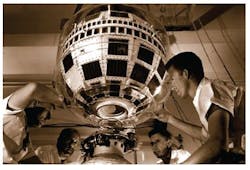On July 10, 1962, Bell Labs partnered with NASA to launch Telstar 1—the world’s first active, direct-relay communications satellite. This move ushered in the era of modern communications, which included real-time global telephone service, data communications, and television broadcasting. Bell Labs still exists today as the research arm of Alcatel-Lucent (www.alcatel-lucent.com). Last month, the company held a celebration to honor Telstar’s launch 50 years ago.
Telstar I achieved many firsts: It successfully transmitted the first television pictures, telephone calls, high-speed data communications and facsimile (fax) images, and live transatlantic television feed through space. The satellite could carry 600 voice calls and one black-and-white TV channel. It incorporated dozens of innovations from Bell Labs, including the transistor. (Telstar incorporated 1000 transistors.) The satellite was powered by 3600 solar cells, which were invented by Bell Labs in 1954. Among other inventions that were critical to Telstar’s operation were microwave amplifiers and rocket guidance systems.
Even by today’s standards, it seems remarkable that all of this innovation could be enabled by a sphere that measured roughly a yard in diameter and weighed about 170 lbs. (Photo 1). "Television was transmitted at the time by microwave towers—beaming the signals from point to point," notes Bell Labs Archivist Ed Eckert. "On land they worked great (and some are still in use today); however, they needed to have a clear line-of-site to transmit. This was incredibly problematic when trying to cross the Atlantic Ocean—some 3500 miles….
1. Pictured is the completed Telstar I satellite.
"A Bell Labs scientist named John Pierce, who was engaged in research around microwave technology, became interested in making a microwave signal bounce," Eckert continues. "In 1960, he tested this theory by using a mylar weather balloon into orbit and bouncing a signal off of it. It was a weak signal, but it worked and the underpinning of what would become Telstar was set into motion. In two years, this went from a theory to a working satellite."
Telstar I was launched on top of a NASA Thor-Delta rocket (Photo 2). It was then placed in an elliptical orbit some 30,000 miles above the Earth’s equator. Between Europe and the US, it had a maximum transmission time of 20 minutes per pass. Once it was in orbit on July 10, the world’s first transatlantic television signal was beamed via Telstar from an earth station in Andover, ME, to a twin station in Pleumeur-Bodou, France (Photo 3). A signal was also received at a sister station in Goonhilly Downs, England.
2. Here, Telstar is mounted to the top of the rocket.
3. Shown is an aerial view of the French Ground Station, Pleumeur-Bodou, in Brittany, France. It was built specifically for the Telstar experiment.
Last month, the 50th anniversary of this communication also was celebrated under the Radome of Pleumeur-Bodou, states Thierry Evanno, Alcatel-Lucent’s Site Director of Lannion, Public Affairs France. Today, that radome is classified as a historic monument and is part of the "Cité des télécoms" museum. During this event, Evanno says, a live satellite transmission was established between Cité des télécoms and the Smithsonian National Air and Space Museum in Washington, DC. Telstar 1 went out of service on February 21, 1963. Yet subsequent Telstar satellites have taken its place including Telstar 18, which launched in 2008.



